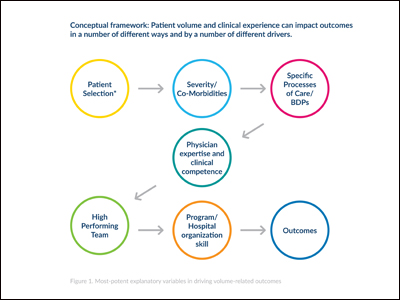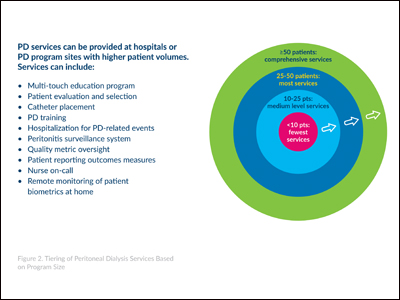Improving PD delivery, outcomes depends on program size, other factors
“We cannot change what we are not aware of, and once we are aware, we cannot help but change.” – Sheryl Sandberg
Can we expect to lower the variability in PD outcomes without substantive change in the design of PD programs in the United States? Peritoneal dialysis remains a recognized treatment option for ESRD, yet several barriers have impeded its broader application.1 Modality-specific complications, including catheter complications, inadequate dialysis, peritonitis, psychosocial concerns and hospitalizations adversely impact PD program growth. These quality challenges and retention of patients on PD concerns begin with several key operational factors, such as the structure of the PD program, experience of the care team, approach toward patient education and care delivery and — a factor not often recognized — the size of the PD program.
During the last decade, there has been significant interest in how patient volume relates to quality in health care. This relationship has been examined within surgical procedures, medical chronic disease management and hospitalizations. For a wide variety of surgical procedures, such as colorectal cancer, bariatric surgery, breast cancer,2 coronary bypass artery grafting and pediatric cardiac surgery, higher volume is associated with better health outcomes.3 The complex reasons for this relationship go beyond the treating physician and may include differences in patient selection, case mix, processes of care and the skill set of the care team. In the dialysis industry, as we work to improve care and outcomes for patients with ESRD, we are looking at what we know about the volume-outcomes impact in medicine and how this can relate to the delivery of PD care.

Size and outcomes
Currently, in the United States, more than 45,000 patients manage their ESRD on PD at home, and patient outcomes vary significantly from program to program. Although some low-volume programs have excellent outcomes and some high-volume programs have poor outcomes, some published reports have noted that smaller PD programs often experience inferior results. Reports from Australia,4 United States,5 Canada,6 the Netherlands7 and France8 highlight the relationship between small center size and lower percent PD penetration and patient outcomes. While the actual patient volume-outcomes tipping point may vary in the literature, the numbers of patients characterizing small programs range from six to 25. Conversely, many programs in China, Taiwan and Hong Kong care for more than 300 patients on PD and characteristically demonstrate superior patient outcomes.9 To maintain positive outcomes, these large programs, whether abroad or in the United States, need to ensure that staffing keeps pace with growth.
In addition to impacting outcomes, center size could impair growth of PD in the United States, according to Finkelstein and colleagues.10 This may be because, hypothetically, smaller programs may have less capacity for educational outreach activities for patients, less capacity for training for patients on PD, potentially less consistency in applying best-demonstrated protocols and risk for lower clinical competence due to fewer patients and less training. An overwhelming percentage of PD programs —whether affiliated with large or medium dialysis organizations, hospitals or independent practices— consistently remain small, rather than consolidate into larger programs. Just like municipalities or other competing entities, practices want to provide local care for their patients without consideration to size. While the intent may be laudable, the results may not be the best for patients.
Why size matters
End-stage renal disease is complex. In turn, the care required to meet the needs of patients with ESRD is also complex, which puts small programs with constrained resources at a disadvantage. Small programs may have more fiscal difficulty designing and implementing the chronic care model.11 This care model was created for patients with chronic illness to transform their daily care from acute and reactive care to proactive, planned and population-based care — with a competent, high-performing team and planned interactions that strengthen the provider-patient relationship. Unfortunately, while a diverse, high-performing care team is now widely recognized as an essential tool for constructing a more patient-centered, coordinated and effective health care delivery system12 especially for complex patients, shrinking reimbursement below a certain payment level makes this model fiscally unrealistic in many small program settings.
Conceptually, the size of the chronic care team may have a tremendous impact on outcomes. A larger team may allow for an increased variety of experience and clinical competence in nurses, social workers, dietitians and physicians. Large centers may have a greater capacity to implement the following five elements that are considered imperative for a successful home dialysis program:13

- a care coordinator, who serves as a quarterback in overseeing patient care;
- a multidisciplinary health care team with medical, behavioral and long-term care experts;
- care collaborators, such as government agencies, faith-based groups and the family and friends of patients;
- informatics, such as digital tools, for more effective patient monitoring and engagement. There exists a hierarchy of data for quality research that could track use of specific processes through the automated logging of process utilization; and
- right incentive structures, in which all team members are rewarded for better health outcomes.
Examining how to design delivery that incorporates these core components is both a challenge and a necessity.
New PD programs and advancing outcomes in small ones
Under the current paradigm, most new programs start out with a “skeleton team” and add personnel as the patient numbers grow. As such, services may be limited, and some programs may stagnate, never getting to the point of adding essential personnel. Yet, if we design programs around achieving quality outcomes and growth, the focus would require a shift from justifying staffing through growth to starting with services designed to improve outcomes. Therefore, new programs should be structured with those critical personnel skill sets to effectively educate for successful shared-decision making, adequately assess new patients (ie, cognitive testing and depression screening), clinically experienced nurses for patient training (duration should be 8 days for desired results),14 timely home visits and capacity to deliver more intense follow-up (through weekly or biweekly clinic visits) for the first 90 days to decrease early patient losses. An early investment in personnel to create the “core team” for a new program can potentially decrease overall PD technique challenges both in the short- and long- term.
Additionally, current small programs, which is less than 10 patients, can take the following steps to help improve outcomes.
Consistently apply clinical and operational best-demonstrated practices to care pathways;
- closely monitor quality metrics;
- perform root cause analysis for all peritonitis, hospitalizations and patient losses;
- regionalize nurse on-call responsibilities; and
- redesign the PD care model through collaboration with other programs.
While consolidation may lead to positive outcomes, it is impractical to think we can drive significant decreases in patient loss by merely consolidating all current units below a certain patient number — nor can we assume that all small programs have the resources or opportunities needed to consolidate. There may be other ways to modify outcomes in small programs without consolidating.
As shown in Figure 2, small programs, rather than consolidating, could outsource certain services—such as catheter placement, trainings, centralizing management of certain quality metrics or joint continuous quality improvement meetings — to more experienced centers with strong core teams. Services not dependent on volume (ie, a clinic visit) could continue in smaller programs. In some cases where a consolidation of bricks and mortar is not the answer, a virtual team network may be a good solution to coordinate care and quality monitoring and decide on appropriate interventions as needed.

Future ways to reshape
Providers need to step back and reimagine how to deliver a model of care for complex patients on PD regardless of program size. The following list describes strategic and operational options to help reshape PD delivery:
- small programs can shift patient training to magnet training centers and catheter placement from low volume and poor outcome hospitals to specialized PD catheter placement sites (PD catheter surgical networks);
- consolidate non-growing, lower quality, small programs into a central care, bricks-and-mortar site;
- develop a hub-and-spoke care model where small programs are actively managed by larger experienced centers (geographically located to provide direct oversite); and
- structure a virtual PD network with telehealth advancements linking small programs with a United States Center of Excellence for PD, including virtual consults, quality reviews and specific quality data surveillance.
Changes critical for the improvement of PD outcomes also involve training for nephrologists and ongoing education for those who perform PD rounds. Nephrologists play a key role in leading the PD care team. They can actively participate in shared-decision making and demonstrate clinical competence in PD; however, this is not always the case. Nephrology specialty boards have not tied in fellowship training, clinical experience and patient training volume in home dialysis for certification or recertification. It remains unclear how much actual experience is needed, but acquiring the right knowledge should have an impact on fellowship credentialing for PD and ongoing certification. This is especially true if the nephrologist is treating only a small number of patients post-training. For the shared-decision making process to be successful, the nephrologist should gain the knowledge necessary to discuss and provide PD or refer patients to a nephrologist who is a specialist in PD.
In time, publicly reported data may identify the highest-quality outcomes achieved by nephrologists and PD programs, which may increase comfort with the modality (among colleagues, payers patients and others) seeking quality outcomes. PD programs could subsequently accrue larger patient volumes and expand PD experience in the process. Can managed care organizations, commercial and government payers, health care systems or individuals contract with only high-volume practices or virtual networks that achieve superior results? Should the public have better access to data on PD patient experience and volume? Should there be tighter regulation of the number of PD centers, similar to transplant center approvals? How can regulatory agencies use data on volume, expertise and outcomes to improve PD delivery models? A number of questions still remain to be answered.
Conclusion
PD program outcomes, despite their variability, show a hint at the true potential of PD to advance survival, lower hospitalization rates and decrease overall ESRD costs of care. There is significant opportunity for positive change in the structure and delivery of PD in the United States. We need to devise approaches that ensure quality care delivery to all patients on PD, even if certain settings require substantial change. Professional societies, payers, government agencies, providers and individual nephrology practices share the responsibility to help optimize the potential of PD and impart the true benefit of this therapy.
Knowing what we currently know, as Sheryl Sandberg said, it is impossible not to change.
- References:
- 1. Schreiber MJ. Sem in Dial. 2017;doi:10.1111/sdi.12576.
- 2. Morche J, et al. Syst Rev. 2016;Nov 29;5:204.
- 3. Halm EA, et al. Ann Intern Med. 2002;Sep 17;137:511-520.
- 4. Htay H, et al. Clin J Am Soc Nephrol. 2017;doi:10.2215/CJN.12321216.
- 5. Afolalu B, et al. Perit Dial Int. 2009;29:292-296.
- 6. Schaubel DE, et al. Kidney Int. 2001; 60:1517-1524.
- 7. Huisman RM, et al. Nephrol Dial Transplant. 2002;17:1655–1660.
- 8. Béchade C, et al. Nephrol Dial Transplant. 2017;doi:10.1093/ndt/gfx051.
- 9. Li PK, et al. Nat Rev Nephrol. 2017;doi:10.1038/nrneph.2016.181.
- 10 Finkelstein F, et al. Blood Purif. 2011; doi:10.3747/pdi.2011.00109.
- 11. Strickland PA, et al. J Am Board Fam Med. 2010;doi:10.3122/jabfm.2010.03.090141.
- 12. Mitchell P, et al. Institute of Medicine; 2012.
- 13. Healthcare for complex populations: The power of whole person care models. Accessed at www.strategyandpwc.com.
- 14. Internal DaVita data.
- For more information
- Martin Schreiber, MD, is the chief medical officer for DaVita Home Modalities, in Denver. The content and opinions provided in this piece belong to Schreiber alone and do not necessarily represent those of DaVita Inc. Disclosure: Schreiber reports no relevant financial disclosures.
